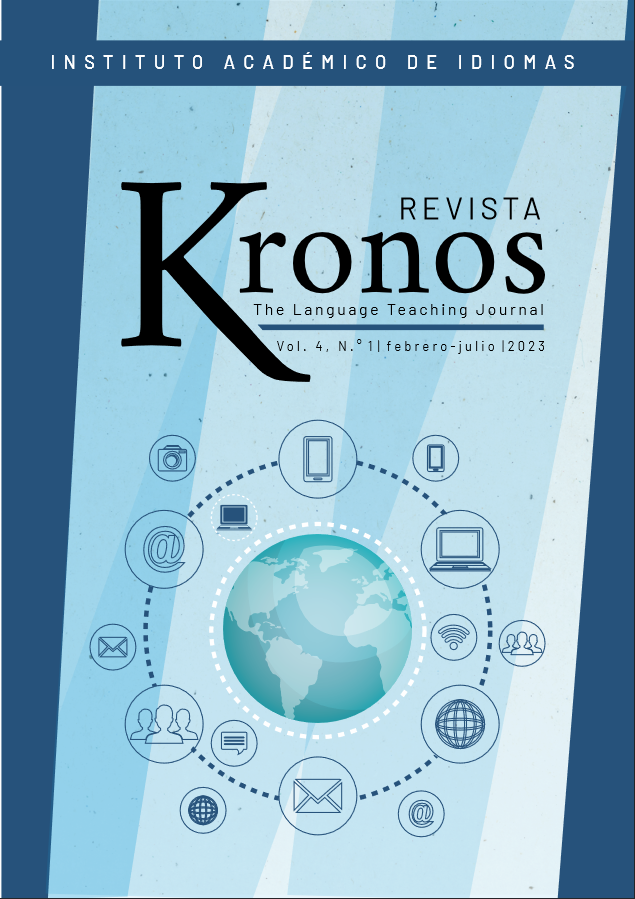Perceptions of peer-teaching strategy in the English major at a public university in Ecuador.
DOI:
https://doi.org/10.29166/kronos.v4i1.4310Keywords:
Peer teaching, English development, teaching strategy, collaborative workAbstract
The aim of this article is to identify the different perceptions of teachers, peer teachers and learners about the peer teaching strategy. Which in detail consists of the process in which students learn from each other, some benefits of this teaching strategy include developing students' collaboration and communication skills, building students' confidence,
and the ability to take control of their own learning. Learners are more comfortable with collaborative work, working with their peers, making them able to interact, engage in reflection, and explore ideas more deeply than in a teach[1]er-tutor-led environment. This research was developed under the principles of qualitative research because it focused
on recollection of the perceptions of the peer teaching strategy of the participants in the English major at a public university in Ecuador, through the application of semi-structured interviews, of the studied subjects who fulfilled the roles of the English teacher, peer teachers and peer learners, throughout the application of the teaching strategy. The analysis of the data collected was thematic, it was concluded from this that both the tutor and the students developed team spirit and more empathetic relationships; increased psychological well-being, social competence, communication skills, and self-esteem; higher performance and higher productivity in terms of better learning outcomes and English development. Overall, peer teaching had a positive impact and taking when it was aimed at students, as well as increased participation and skills of peer teachers and learners.
Downloads
References
Adil, H., & Ali, A. (2018). Implementing Peer Teaching to Enhance English Students’ Language Learning: Kurdish efl Teachers’ and Students’ Perspectives. Journal of Garmian
University, 5(1), 1-24. https://doi.org/10.24271/GARMIAN.300
Al-Jbouri, et al. (2019). Peer Groups. Encyclopedia of Evolutionary Psychological Science, 1,
-9. https://doi.org/10.1007/978-3-319-16999-6_155-1
Aggarwal, P., & O’Brien, C. L. (2008). Social loafing on group projects: Structural antecedents and effect on student satisfaction. Journal of marketing education, 30(3), 255-264.
https://doi.org/10.1177/0273475308322283
Benson, P., & Ying, D. (2013). Peer teaching as a pedagogical strategy for autonomy in
teacher education. Chinese Journal of Applied Linguistics, 36(1), 50-68. https://doi.
org/10.1515/cjal-2013-0004
Bhardwaj, P. (2019). Types of sampling in research. Journal of the Practice of Cardiovascular
Sciences, 5(3), 157. https://doi.org/10.4103/jpcs.jpcs_62_19
Boud, et al. (1999). Peer learning and assessment. Assessment & evaluation in higher education, 24(4), 413-426. https://doi.org/10.1080/0260293990240405
Bulte, et al. (2007). Student teaching: views of student near-peer teachers and learners.
Medical teacher, 29(6), 583-590. https://doi.org/10.1080/01421590701583824
Burton, B. (2012). Peer teaching as a strategy for conflict management and student re-engagement in schools. The Australian Educational Researcher, 39(1), 45-58. https://doi.
org/10.1007/s13384-011-0046-4
Chih-Pei, H. & Chang, Y. (2017). John W. Creswell, research design: Qualitative, quantitative, and mixed methods approaches. Journal of Social and Administrative Sciences,
(2), 205-207. http://dx.doi.org/10.1453/jsas.v4i2.1313
Coenen, M. (2002). Using gifted students as peer tutors. Gifted Child Today, 25(1), 48-58.
https://doi.org/10.4219/gct-2002-49
Fani, T., & Ghaemi, F. (2011). Implications of Vygotsky’s zone of proximal development
(zpd) in teacher education: zptd and self-scaffolding. Procedia-Social and Behavioral
Sciences, 29, 1549-1554. https://doi.org/10.1016/j.sbspro.2011.11.396
Gordón, E. (2005). Peer Tutoring: A teacher’s Resource Guide. Scarecrow Education. https://books.google.es/books?hl=es&lr=&id=qRZS-fBOSgwC&oi=fnd&pg=PP7&dq=Gordon,+E.+(2005).+Peer+Tutoring:+A+teacher%E2%80%99s+Resource+Guide.+Scarecrow+Education&ots=dLi7pXzxoV&sig=YmlMbIarPTbsI2fTVrz4woj12jY#v=onepage&q=Gordon%2C%20E.%20(2005).%20Peer%20
Tutoring%3A%20A%20teacher%E2%80%99s%20Resource%20Guide.%20Scarecrow%20Education&f=false
Grubbs, N. (2009). The Effects of the Peer Tutoring Program: An Action Research
Study of the Effectiveness of the Peer Tutoring Program at One Suburban Middle
School. Georgia School Counselors Association Journal, 16(1), 21-31. https://eric.ed.gov
/?id=EJ871911
Hanrahan, S., & Isaacs, G. (2001). Assessing self-and peer-assessment: The students’ views. Higher Education Research & Development, 20(1), 53-70. https://doi.
org/10.1080/07294360123776
Johnson, E. (2015). Peer-Teaching in the Secondary Music Ensemble. Journal of Education
and Training Studies, 3(5), 35-42. http://dx.doi.org/10.11114/jets.v3i5.906
Karimi-Aghdam, S. (2017). Zone of proximal development (zpd) as an emergent system:
A dynamic systems theory perspective. Integrative Psychological and Behavioral Science,
, 76-93. https://link.springer.com/article/10.1007/s12124-016-9359-1
Kavanoz, S., & Yüksel, H. (2010). An investigation of peer-teaching technique in student
teacher development. The International Journal of Research in Teacher Education,
Lim, L. (2014). A Case Study on Peer-Teaching. Open Journal of Social Sciences, 2(8),
-40. http://dx.doi.org/10.4236/jss.2014.28006
Manchishi, P. & Mwanza, D. (2016). Teacher Preparation at the University of Zambia: Is
Peer Teaching Still a Useful Strategy? International Journal of Humanities Social Sciences
Educations (ijhsse), 3(11), 88-100. https://doi.org/10.20431/2349-0381.0311012
McKenna, L., & French, J. (2011). A step ahead: Teaching undergraduate students to be
peer teachers. Nurse Education in Practice, 11(2), 141-145. https://doi.org/10.1016/j.
nedt.2012.10.016
Rankin, A. & Berman, J. (2018). Striving for Best Practices in Peer Tutoring. Vanier Academic Voices, 1(1), 1-28. https://eduq.info/xmlui/bitstream/handle/11515/35610/
rankin-berman-striving-best-practices-peer-tutoring-VAV-1-1.pdf?sequence=2
Rusli, M et al. (2021). Peer teaching: Students teaching students to increase academic
performance. Teach Theol Relig., 24(1): 17-27. https://doi.org/10.1111/teth.12549
Selvi, K. (2008). Phenomenological approach in education. In Education in human creative
existential planning (pp. 39-51). Springer, Dordrecht. https://doi.org/10.1007/978-
-4020-6302-2_4
Stigmar, M. (2016). Peer-to-peer teaching in higher education: A critical literature review.
Mentoring & Tutoring: partnership in learning, 24(2), 124-136. http://dx.doi.org/10.1
/13611267.2016.1178963
Sunggingwati, D. (2018). Cooperative learning in peer teaching: A case study in an
efl context. Indonesian Journal of Applied Linguistics, 8(1), 149-157. https://doi.
org/10.17509/ijal.v8i1.11475
Topping, K. (2005). Trends in peer learning. Educational Psychology, 25(6), 631–645.
https://doi.org/10.1080/01443410500345172
Torre, et al. (2016). Theoretical perspectives and applications of group learning in pbl.
Medical teacher, 38(2), 189-195. https://doi.org/10.3109/0142159X.2015.1009429
Utha, K. & Rinzin, S. (2019). Peer-learning: An Alternative Teaching Pedagogy for Highly
Teacher Centered Classes. International Journal of English, Literature and Social Science
(ijels), 4(5), 1520-1529. https://dx.doi.org/10.22161/ijels.45.41
Wagner, M. & Gansemer-Topf, A. (2005). Learning by teaching others: A qualitative study
exploring the benefits of peer teaching. Landscape journal, 24(2), 198-208. https://
doi.org/10.3368/lj.24.2.198
Published
How to Cite
Issue
Section
License
Copyright (c) 2023 Lisseth Estefania Chango Parra, Gabriela Córdova López, Olga González Ortiz

This work is licensed under a Creative Commons Attribution-NonCommercial-ShareAlike 4.0 International License.












